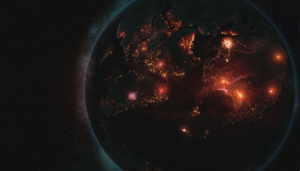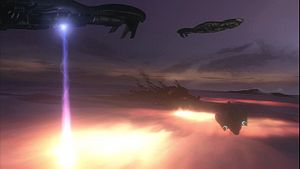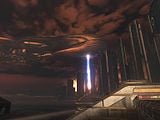Glassing: Difference between revisions
From Halopedia, the Halo wiki
m (→Doctrine) |
Durandal-217 (talk | contribs) |
||
| Line 6: | Line 6: | ||
==Doctrine== | ==Doctrine== | ||
[[File:7inTheSky.png|thumb|right|300px| | [[File:7inTheSky.png|thumb|right|300px|A orbital lance strikes Reach's surface.]] | ||
[[File:Halo3 E3 TRAILER 2007 720p30 ST 6300Kbps 002 0001.jpg|thumb|right|300px|Two {{Class|CCS|Battlecruiser}}s perform a low range glassing of [[Voi]].]] | [[File:Halo3 E3 TRAILER 2007 720p30 ST 6300Kbps 002 0001.jpg|thumb|right|300px|Two {{Class|CCS|Battlecruiser}}s perform a low range glassing of [[Voi]].]] | ||
Glassing, a destructive process which signifies an end to a planetary body, begins with the discovery of an enemy controlled world — in most cases the Covenant will immediately begin glassing a planet, however there are engagements where the Covenant have to deploy ground forces for various reasons, usually to search or secure a [[Forerunner]] artifact. A [[Minor Prophet]] is assigned to most Covenant fleets to oversee the destruction of a human world; before the fleet is permitted to destroy a planet, the Prophet performs a religious ritual - this process lasts an hour, and when completed, the Prophet declares by which religious significance, marked by a glyph, will the world be destroyed. There is currently only one known instance of a [[Kholo|human world]] having a glyph burned into its surface.<ref>'''[[Halo: Evolutions - Essential Tales of the Halo Universe|Halo: Evolutions]]''', ''[[The Return]]'', ''pages 494-496''</ref> The Covenant will then begin glassing the planet by moving their large warships close and blanket the world with a series of crisscrossing orbits to ensure that every square millimeter of the surface is destroyed.<ref name="Strike"/> Throughout the war, the Covenant have been known to utilize two methods of glassing. | Glassing, a destructive process which signifies an end to a planetary body, begins with the discovery of an enemy controlled world — in most cases the Covenant will immediately begin glassing a planet, however there are engagements where the Covenant have to deploy ground forces for various reasons, usually to search or secure a [[Forerunner]] artifact. A [[Minor Prophet]] is assigned to most Covenant fleets to oversee the destruction of a human world; before the fleet is permitted to destroy a planet, the Prophet performs a religious ritual - this process lasts an hour, and when completed, the Prophet declares by which religious significance, marked by a glyph, will the world be destroyed. There is currently only one known instance of a [[Kholo|human world]] having a glyph burned into its surface.<ref>'''[[Halo: Evolutions - Essential Tales of the Halo Universe|Halo: Evolutions]]''', ''[[The Return]]'', ''pages 494-496''</ref> The Covenant will then begin glassing the planet by moving their large warships close and blanket the world with a series of crisscrossing orbits to ensure that every square millimeter of the surface is destroyed.<ref name="Strike"/> Throughout the war, the Covenant have been known to utilize two methods of glassing. | ||
Revision as of 14:06, November 11, 2010

- "You are...all of you...vermin. Cowering in the dirt thinking... what, I wonder? That you might escape the coming fire? No. Your world will burn until its surface is but glass!"
- — Prophet of Truth
The term glassing, also known as plasma bombardment[1], is used to refer to the act by which a Covenant ship or ships bombard a planet from orbit using heavy plasma weaponry.
Doctrine
Glassing, a destructive process which signifies an end to a planetary body, begins with the discovery of an enemy controlled world — in most cases the Covenant will immediately begin glassing a planet, however there are engagements where the Covenant have to deploy ground forces for various reasons, usually to search or secure a Forerunner artifact. A Minor Prophet is assigned to most Covenant fleets to oversee the destruction of a human world; before the fleet is permitted to destroy a planet, the Prophet performs a religious ritual - this process lasts an hour, and when completed, the Prophet declares by which religious significance, marked by a glyph, will the world be destroyed. There is currently only one known instance of a human world having a glyph burned into its surface.[2] The Covenant will then begin glassing the planet by moving their large warships close and blanket the world with a series of crisscrossing orbits to ensure that every square millimeter of the surface is destroyed.[1] Throughout the war, the Covenant have been known to utilize two methods of glassing.
Orbital bombardment
The first and the most commonly used method, is when the Covenant's large warships aim their plasma turrets, toward the planet's surface and build up plasma along their lateral lines. The plasma is then discharged in lances from the warship as it continues to orbit the planet - contained within a magnetic bubble, the lances are guided towards the surface by the ships automation, striking an area and converting the top soil and other surface geology into a mineral called lechatelierite that is similar to glass[3], hence its name. The process also vaporizes any bodies of water the planet may possess, or at least reduces the remaining water to small, ash-choked pools. The ecosystem of a planet is also disposed of through this process. This is repeated until every square centimeter of the planet is destroyed; depending on the planet, the technology and the number of ships in the Covenant fleet, it can take the Covenant a minimum of some hours, or up to two days to glass a planet.[4]
The impact of the plasma bolt is similar to that of a nuclear detonation on a much different scale. When the plasma bolt impacts the surface, the magnetic field sustaining and guiding the plasma collapses, and, depending on how powerful the release of energy is, the initial zone of impact is obliterated instantly. The areas outside of the initial impact zone are affected by the heat wave generated by the blast; depending on the range, those closest outside of the blast zone are instantly killed by the intense heat. As thermal expansion takes over, the resulting flames fan out and create a pyroclastic surge[5], which will continue to burn the areas it comes into contact with until it has cooled enough that it cannot harm the surface.
Subsequently, the atmosphere is saturated with soot and ash thrown up from the initial impact, subjecting the planet to a nuclear winter. As the initial impact area cools, the surface is covered by extensive areas of molten soil, and is comparable to active volcanic sites in some parts of the world, on a larger scale depending on the extent. The destructive process leaves the planet unable to recover to its former state. As a result of the destruction, the atmospheres of most planets have been known to boil away from the process[6], though not all planets suffered this, with the most notable exception being Reach.
Low range bombardment
The second method is used when a ship must effectively destroy a ground target from low range. This method involves focusing plasma though a magnetic envelope from the energy projector located on the underside of the ship, and then discharging the plasma as a narrow beam. This method of low-range glassing has only been witnessed a few times, most notably during the Harvest campaign and the Battle of Pegasi Delta, as well as the glassing of New Mombasa and Voi during the Battle of Earth.[7] This method of glassing can be used to excavate areas of interest for the Covenant, such as unearthing the portal to the the Ark during the Battle of Earth.
Two types of low-range bombardment have been observed: A broader white/purple beam that is used for excavation, and a much more powerful blood-red beam intended for actual glassing. The difference may be a result of the intensity of the beam's energy.
History
Since the formation of the Covenant in 852 B.C.E. the Covenant have used their ship-borne plasma weapons to threaten the lesser species of the Covenant into a truce and their eventual induction into the Covenant. The Lekgolo were the first to be threatened with such destruction because of their transgressions against Forerunner technology before becoming the first outside species to join the Covenant in 784 B.C..[8][9] The Unggoy almost faced orbital bombardment for their Rebellion in 2462 C.E, or the 39th Age of Conflict by Covenant records.[10][11] Although the Kig-Yar were not threatened with orbital bombardment, they were quick to realize the Covenant had such a capacity to destroy them and thus chose to join the Covenant for greater wealth that the Covenant would provide.
Human-Covenant War
- Main article: Human-Covenant War
After the Prophets declaration to wipe out humanity, the Covenant would put all of their destructive methods to use, and throughout the Human-Covenant War, the Covenant aggressors glassed a significant majority of the UNSC's colony worlds from orbit. Although ground forces were often deployed first, as UNSC forces were routed in space, the bombardment would commence.[12] The first planet to suffer this fate was Harvest, glassed from the Jiralhanae-operated cruiser Rapid Conversion.[13]
The destruction of a human controlled world varies upon many different factors, from the world itself and its defenses, to the requirements of the Covenant fleet and its leader be it a Fleet Master or a Prophet.[14] Undeveloped human colonies, ones that are atmospheric contained habitats or stations, are typically destroyed while the rest of the world is left unharmed - well developed planets that have been terraformed or inhabited are destroyed by many different methods.[15]
It has been noted that areas of interest to the Covenant are left intact for reasons of study or retrieval; however, this is not common, as only three planets have been partially glassed and only when a Forerunner Artifact was discovered.[16] After the Covenant glasses a planet, a shard of glass is removed and placed in the Sanctum of the Hierarchs within High Charity.[17]
The Battle of Earth culminated in the glassing of the city of Voi in Africa by Covenant Separatists, in an effort to contain a Flood infestation which had come to Earth only hours earlier.[18] Lord Hood accuses the Sangheili lead fleet of glassing half of the continent, but given his distaste for his former enemies, he might have exaggerated about the actual extent of the glassing.
Halo Wars
- Main article: Halo Wars
In Halo Wars, the Prophet of Regret faction of the Covenant are able to use the Prophet to call down a Cleansing Beam from an orbiting Covenant ship. Rather than a leader power, this is treated as the unit's secondary ability, using the Y button to guide the beam at the cost of resources every second. It lacks the power of typical glassing maneuvers seen in past canon to balance gameplay much like Captain Cutter's ability to fire a MAC blast at enemy targets.
List of known glassed worlds
Trivia
- It has been noted that UNSC territory encompassed over eight-hundred planets at the beginning of the Human-Covenant War, most of which were glassed by the Covenant.[19][20]
- The term "glassing" was originally coined by the Assembly in 2526, who chose it hoping it would galvanize humanity into action. At the time, the Assembly also estimated that it would take 30.3801 years for a Covenant fleet of comparable size to that of the UNSC's to glass the entirety of Earth. However, the Covenant fleet was later discovered to be many times larger than imagined, with the power of the Covenant's weaponry also underestimated.[21]
- Though glassing was previously thought to be permanent, it is possible through terraforming to reclaim the environment of a glassed planet, though a planet such as Reach was shown to have taken at least 37 years to recover.
Gallery
- Glassinglaz0r.jpg
The Prophet of Regret's Cleansing beam in Halo Wars.
- HW genis back cover.png
Three Covenant Destroyers glassing Harvest.
- Kholo.png
Covenant ships glassing Kholo.
A Shipmaster during the ritual destruction of Kholo, overseen by a Prophet.
A CCS-class Battlecruiser glassing New Alexandria.
List of appearances
- Halo 2
- Halo 3
- Halo 3: ODST
- Halo Wars
- Halo: Reach
- Halo: The Fall of Reach (First appearance)
- Halo: First Strike
- Halo: Ghosts of Onyx
- Halo: Contact Harvest
- Halo: The Cole Protocol
- Halo: Evolutions - Essential Tales of the Halo Universe
- Halo Legends
Notes
Sources
- ^ a b Halo: First Strike, chapter 11, page 105
- ^ Halo: Evolutions, The Return, pages 494-496
- ^ Lechatelierite on Wikipedia
- ^ Halo Legends (2010), Bonus Feature Halo: The Story So Far
- ^ Pyroclastic Surge on Wikipedia
- ^ Halo: The Fall of Reach, page 8
- ^ Halo:Ghosts of Onyx, Prologue, page 25
- ^ Halo: Contact Harvest, Chapter 16, page 270
- ^ Halo Encyclopedia, chapter 4, page 114
- ^ Halo: Contact Harvest, Chapter 9, page 151
- ^ Halo Encyclopedia, Chapter 4, page 142
- ^ Halo: The Fall of Reach, Chapter 19, page 173
- ^ Halo: Contact Harvest, Chapter 17, page 285
- ^ Halo: The Cole Protocol, Chapter 19, page 148
- ^ Halo: Evolutions, The Return, page 494
- ^ Halo: First Strike, Chapter 13, page 122
- ^ Halo: First Strike, Epilogue, page 338
- ^ Halo 3, campaign level Floodgate
- ^ Halo Encyclopedia, Chapter 1, page 33
- ^ Xbox.com: The Halo Timeline
- ^ Halo: Reach, Data pads






